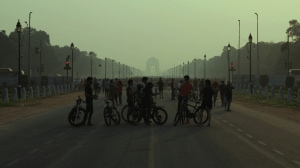Identity of Noida assailants still uncertain
NOIDA, August 18: The Pandit family had got together after almost a year: ripples of laughter echoed through their sprawling bungalow at ...

NOIDA, August 18: The Pandit family had got together after almost a year: ripples of laughter echoed through their sprawling bungalow at Sector 14, as three tiny-tots scampered across the floors and played hide and seek with their beaming grandparents — Col (retd) Ravi Pandit and his wife Dr Kusum Pandit.
Last Sunday was no different — till the family went to sleep. Just after midnight, they were forced awake from their happy slumber to face the brutality of four unidentified lathi-wielding men. The violence was unprovoked, quick and reckless.
One of the officers investigation the case, Rajbir Singh Bhawan said: “We are convinced that the assailants were Pardis.” When asked why, he meekly explained: “Senior Delhi police officers visited the spot and said the modus operandi was similar to that of the Pardis or Bawarias. The Delhi Police have previous experience in investigating such cases. There is no reason why we should disagree with their opinion.”
The opinion of the Delhi police and their UP counterparts is, however, based on too many assumptions. They said the time of attack and the weapons — sticks shaped from freshly cut branches of the Eucalyptus tree — indicates a similarity to methods adopted by the nomadic tribals in previous incidents, including a raid at Sector-40 in Noida last year.
Sunday’s victims suffered serious head injuries: Bawaria and Pardi tribals are known to target the head of a victim.
But the methodical approach of the assailants and their descriptions given by the Pandits’ daughters-in-law also indicates that assailants could be impersonators, probably local labourers, rickshaw-pullers or vendors. The police do not rule out such a possibility, but say it is unlikely.
There are two doors to the room through which the assailants gained access to the house. The first door – meticulously crafted with several window panes — was left ajar by the occupants. The second door, a framework of wire meshes and wood, was bolted from the inside.
It was obvious that the assailants placed a metal rod or a daulatiya between the wooden beam above the door and the upper portion of the door to push the latch backward. A gentle pull did the rest. Bawarias and Pardis, on the other hand, are known to pull out whole doors from hinges or the locking mechanism on the doors.
Niti Pandit, Col. Pandit’s daughter-in-law, told Express Newsline that the assailants were shabbily dressed, but looked very sturdy. “They looked like labourers. They were dark and short, probably a little more than five feet tall,” she said, “and they were wearing dirty T-shirts and shorts.”
The police, however, said that Niti’s statements are incoherent because she is traumatised. Her description of the assailants is also vague and therefore computer sketches cannot be prepared and used to identify possible criminals.
None of the assailants spoke at all. Even as they rained blows on her head, face and arms, Niti pleaded with them to spare the children.
The assailants spared the children but mercilessly thrashed the elders in the other bedrooms before ransacking the house. Dr Kusum Pandit was declared dead on arrival at Kailash hospital. Her husband and sons Rajeev, a chemical engineer in a multinational, and Sanjeev, a major in the Indian Army, are still in the intensive care unit.
Both daughters-in-law — Vineeta and Niti — are out of the ICU but in a state of shock. They have managed to give statements to the UP police, following which investigations have commenced with the presumption that the assailants were nomadic tribals.
Eight UP police teams are working on the case. These teams have been sent to Muzaffarnagar, Saharanpur, Ghaziabad, Haryana, Madhya Pradesh and Delhi to identify possible hideouts of the assailants.
“We have sufficient reasons to rule out the possibility of the involvement of local or interstate ordinary criminals operating in the area,” said Senior Superintendent of Police (Gautam Buddha Nagar) Devendra Singh Chauhan.“If the miscreants would have been locals they would have touched the costly electronic items and other valuables of the house. But they fled only with cash and jewellery.”
Chauhan’s conclusion is “these tribes do not follow their classical modus operandi any longer”. And the `proof’, he said: “Pardis act more mercilessly than Bawarias. Since in this case all except one of the occupants of the house survived, we suspect the Bawarias. But Bawarias usually take food from the victims’ house after an attack. In this case the miscreants did not touch any edibles. Sixty percent of the clues indicate that Pardis were behind the incident, while 40 percent point towards Bawarias.”






- 01
- 02
- 03
- 04
- 05

























